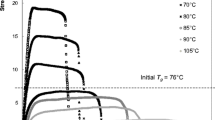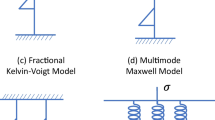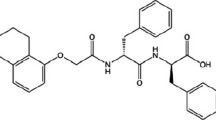Abstract
The effects of ultrasound (US) pretreatment, heat pump drying temperature and drying time on the water status and viscoelastic properties as well as the correlation between them of scallop adductors were investigated. As drying progressed, the transverse relaxation time (T2) of tightly and loosely bound water maintained a relatively stable state, while the T2 of free and immobilized water shifted leftwards with US pretreatment and increasing drying temperature. The creep compliance was increased, but the relaxation modulus decreased with US pretreatment and an increase in drying temperature. However, the creep compliance exhibited a decreasing trend, but the relaxation modulus showed an increase tendency as drying proceeded, viz., decreasing moisture content. Burger’s model and the three-element generalized Maxwell model achieved the best fit to describe the creep behavior and stress relaxation, respectively. The storage modulus (G′) and loss modulus (G″) were decreased with US pretreatment, increasing the drying temperature and moisture content. The T2 of all water components and peak area fraction of immobilized water were positively correlated with the creep compliance but significantly negatively correlated with the stress relaxation modulus, G′ and G″. Low-field nuclear magnetic resonance provided reliable viscoelastic properties of scallop adductors by monitoring the water status during the drying process, which can be used to accurately control the final product quality.






Similar content being viewed by others
Data Availability
All data generated or analyzed during this study are included in this published paper. All the data included in this study are available from the corresponding author upon suitable request.
References
Abedi, F. M., & Takhar, P. S. (2022). Stress relaxation properties of bananas during drying. Journal of Texture Studies, 53(1), 146–156. https://doi.org/10.1111/jtxs.12637.
Abedi, E., Mousavifard, M., & Hashemi, S. M. B. (2022). Ultrasound-assisted detoxification of ochratoxin A: Comparative study of cell wall structure, hydrophobicity, and toxin binding capacity of single and co-culture lactic acid bacteria. Food and Bioprocess Technology, 15(3), 539–560. https://doi.org/10.1007/s11947-022-02767-7.
An, N. N., Lv, W. Q., Li, D., Wang, L. J., & Wang, Y. (2023). Effects of hot-air microwave rolling blanching pretreatment on the drying of turmeric (Curcuma longa L.): Physiochemical properties and microstructure evaluation. Food Chemistry, 398, 133925. https://doi.org/10.1016/j.foodchem.2022.133925
Bassey, E. J., Cheng, J. H., & Sun, D. W. (2021). Novel nonthermal and thermal pretreatments for enhancing drying performance and improving quality of fruits and vegetables. Trends in Food Science & Technology, 112, 137–148. https://doi.org/10.1016/j.tifs.2021.03.045.
Cai, L., Feng, L., Nie, M., Li, D., Zheng, T., & Zhang, M. (2023). Effect of different hydrocolloids on the rheological, microstructural, and 3D printing characteristics of purple sweet potato puree. Food and Bioprocess Technology, 16(11), 2622–2634. https://doi.org/10.1007/s11947-023-03085-2.
Carvalho, G. R., Rojas, M. L., Silveira, I., & Augusto, P. E. D. (2020). Drying accelerators to enhance processing and properties: Ethanol, isopropanol, acetone and acetic acid as pre-treatments to convective drying of pumpkin. Food and Bioprocess Technology, 13(11), 1984–1996. https://doi.org/10.1007/s11947-020-02542-6.
Casco, M. A., Jagus, R. J., Agüero, M. V., & Fernandez, M. V. (2022). Ultrasound and its combination with natural antimicrobials: Effects on shelf life and quality stability of a fruit and vegetable smoothie. Food and Bioprocess Technology, 15(1), 203–218. https://doi.org/10.1007/s11947-021-02745-5.
Chakraborty, I., Mal, N. P., Paul, S. S., Rahman, U. C., M. H., & Mazumder, N. (2022). An insight into the gelatinization properties influencing the modified starches used in food industry: A review. Food and Bioprocess Technology, 15(6), 1195–1223. https://doi.org/10.1007/s11947-022-02761-z.
Chattong, U., Apichartsrangkoon, A., Chaikham, P., Supavititpatana, T., & Bell, A. E. (2015). Viscoelastic properties and physicochemical characteristics of pressurized ostrich-meat emulsions containing gum additives. Innovative Food Science & Emerging Technologies, 32, 64–69. https://doi.org/10.1016/j.ifset.2015.07.001.
Cheng, S., Zhang, T., Yao, L., Wang, X., Song, Y., Wang, H., Wang, H., & Tan, M. (2017). Use of low-field-NMR and MRI to characterize water mobility and distribution in pacific oyster (Crassostrea gigas) during drying process. Drying Technology, 36(5), 630–636. https://doi.org/10.1080/07373937.2017.1359839
Cheng, S., Tang, Y., Zhang, T., Song, Y., Wang, X., Wang, H., Wang, H., & Tan, M. (2018). Approach for monitoring the dynamic states of water in shrimp during drying process with LF-NMR and MRI. Drying Technology, 36(7), 841–848. https://doi.org/10.1080/07373937.2017.1357569
da Silva, B. D., Rosário, de Aguiar Bernardo, D. K. A., Y. A., & Conte-Junior, C. A. (2023). Improvement of physicochemical and antibacterial properties of nanoemulsified origanum vulgare essential oil through optimization of ultrasound processing variables. Food and Bioprocess Technology, 16(9), 2016–2026. https://doi.org/10.1007/s11947-023-03050-z.
de Vargas, V. H., Marczak, L. D. F., Flôres, S. H., & Mercali, G. D. (2022). Advanced technologies applied to enhance properties and structure of films and coatings: A review. Food and Bioprocess Technology, 15(6), 1224–1247. https://doi.org/10.1007/s11947-022-02768-6.
Deng, L. Z., Mujumdar, A. S., Zhang, Q., Yang, X. H., Wang, J., Zheng, Z. A., Gao, Z. J., & Xiao, H. W. (2019). Chemical and physical pretreatments of fruits and vegetables: Effects on drying characteristics and quality attributes - a comprehensive review. Critical Reviews in Food Science and Nutrition, 59(9), 1408–1432. https://doi.org/10.1080/10408398.2017.1409192
Gulati, T., & Datta, A. K. (2015). Mechanistic understanding of case-hardening and texture development during drying of food materials. Journal of Food Engineering, 166, 119–138. https://doi.org/10.1016/j.jfoodeng.2015.05.031.
Han, J. R., Shang, W. H., Yan, J. N., Du, Y. N., McClements, D. J., Xiao, H., Wu, H. T., & Zhu, B. W. (2020). Protection of β-carotene from chemical degradation in emulsion-based delivery systems using scallop (Patinopecten Yessoensis) gonad protein isolates. Food and Bioprocess Technology, 13(4), 680–692. https://doi.org/10.1007/s11947-020-02429-6.
Heidary, A., & Soltanizadeh, N. (2024). The effects of high-pressure homogenization on physicochemical and functional properties of gelatin. Food and Bioprocess Technology, 17(1), 100–122. https://doi.org/10.1007/s11947-023-03113-1
Jadhav, H. B., Raina, I., Gogate, P. R., Annapure, U. S., & Casanova, F. (2023). Sonication as a promising technology for the extraction of triacylglycerols from fruit seeds—A review. Food and Bioprocess Technology, 16(8), 1625–1651. https://doi.org/10.1007/s11947-022-02987-x.
Jiang, N., Liu, C., Li, D., Zhang, J., Zhang, Z., Huang, J., & Yu, Z. (2018). Effect of thermosonic pretreatment and microwave vacuum drying on the water state and glass transition temperature in Agaricus Bisporus slices. Food and Bioprocess Technology, 11(1), 172–184. https://doi.org/10.1007/s11947-017-2004-2.
Joardder, M. U., Kumar, C., & Karim, M. A. (2017). Food structure: Its formation and relationships with other properties. Critical Reviews in Food Science and Nutrition, 57(6), 1190–1205. https://doi.org/10.1080/10408398.2014.971354.
Khan, M. I. H., & Karim, M. A. (2017). Cellular water distribution, transport, and its investigation methods for plant-based food material. Food Research International, 99(Pt 1), 1–14. https://doi.org/10.1016/j.foodres.2017.06.037.
Khan, M. I. H., Patel, N., Mahiuddin, M., & Karim, M. A. (2021). Characterisation of mechanical properties of food materials during drying using nanoindentation. Journal of Food Engineering, 291, 110306. https://doi.org/10.1016/j.jfoodeng.2020.110306.
Khan, M. I. H., Longa, D., Sablani, S. S., & Gu, Y. (2023). A novel machine learning–based approach for characterising the micromechanical properties of food material during drying. Food and Bioprocess Technology, 16(2), 420–433. https://doi.org/10.1007/s11947-022-02945-7.
Li, Q., Li, D., Wang, L., Özkan, N., & Mao, Z. (2010). Dynamic viscoelastic properties of sweet potato studied by dynamic mechanical analyzer. Carbohydrate Polymers, 79(3), 520–525. https://doi.org/10.1016/j.carbpol.2009.08.035.
Li, L., Ren, X., Chen, J., Cao, W., Ren, G., Bhandari, B., Ren, A., & Duan, X. (2022). Changes and relationships of viscoelastic and physical properties of Chinese yam during a novel multiphase microwave drying process. LWT-Food Science and Technology, 168, 113969. https://doi.org/10.1016/j.lwt.2022.113969.
Liu, Y., Zeng, Y., Hu, X., & Sun, X. (2020). Effect of ultrasonic power on water removal kinetics and moisture migration of kiwifruit slices during contact ultrasound intensified heat pump drying. Food and Bioprocess Technology, 13(3), 430–441. https://doi.org/10.1007/s11947-019-02401-z.
Liu, B., Li, D. Y., Wu, Z. X., Yang, W. J., Zhou, D. Y., & Zhu, B. W. (2022a). Combined effects of ultrasound and antioxidants on the quality maintenance of bay scallop (Argopecten irradians) adductor muscles during cold storage. Ultrasonics Sonochemistry, 82, 105883. https://doi.org/10.1016/j.ultsonch.2021.105883
Liu, Y. Y., Sun, W. H., Li, B. Z., Wang, Y., Lv, W. Q., Shang, N., Li, D., & Wang, L. J. (2022b). Dehydration characteristics and evolution of physicochemical properties of Platycodon grandiflorum (Jacq. A.DC.) Roots (PGR) during pulse-spouted microwave vacuum drying (PSMVD). Industrial Crops and Products, 177, 114449. https://doi.org/10.1016/j.indcrop.2021.114449.
Llavata, B., Femenia, A., Clemente, G., & Cárcel, J. A. (2024). Combined effect of airborne ultrasound and temperature on the drying kinetics and quality properties of kiwifruit (Actinidia Deliciosa). Food and Bioprocess Technology, 17(2), 440–451. https://doi.org/10.1007/s11947-023-03138-6
Mahiuddin, M., Khan, M. I. H., Kumar, C., Rahman, M. M., & Karim, M. A. (2018). Shrinkage of food materials during drying: Current status and challenges. Comprehensive Reviews in Food Science and Food Safety, 17(5), 1113–1126. https://doi.org/10.1111/1541-4337.12375.
Majumder, P., Sinha, A., Gupta, R., & Sablani, S. S. (2021). Drying of selected major spices: Characteristics and influencing parameters, drying technologies, quality retention and energy saving, and mathematical models. Food and Bioprocess Technology, 14(6), 1028–1054. https://doi.org/10.1007/s11947-021-02646-7.
Meng, X., Li, T., Zhao, J., Fan, M., Qian, H., Li, Y., & Wang, L. (2023). Effects of different bran pretreatments on rheological and functional properties of triticale whole-wheat flour. Food and Bioprocess Technology, 16(3), 576–588. https://doi.org/10.1007/s11947-022-02959-1.
Nonglait, D. L., & Gokhale, J. S. (2023). Review insights on the demand for natural pigments and their recovery by emerging microwave-assisted extraction (MAE). Food and Bioprocess Technology. https://doi.org/10.1007/s11947-023-03192-0. (in press).
Nunes, B. V., da Silva, C. N., Bastos, S. C., & de Souza, V. R. (2022). Microbiological inactivation by ultrasound in liquid products. Food and Bioprocess Technology, 15(10), 2185–2209. https://doi.org/10.1007/s11947-022-02818-z.
Okonkwo, V. C., Mba, O. I., Kwofie, E. M., & Ngadi, M. O. (2021). Rheological properties of meat sauces as influenced by temperature. Food and Bioprocess Technology, 14(11), 2146–2160. https://doi.org/10.1007/s11947-021-02709-9.
Osae, R., Essilfie, G., Alolga, R. N., Akaba, S., Song, X., Owusu-Ansah, P., & Zhou, C. (2020). Application of non-thermal pretreatment techniques on agricultural products prior to drying: A review. Journal of the Science of Food and Agriculture, 100(6), 2585–2599. https://doi.org/10.1002/jsfa.10284.
Ozturk, O. K., & Takhar, P. S. (2017). Stress relaxation behavior of oat flakes. Journal of Cereal Science, 77, 84–89. https://doi.org/10.1016/j.jcs.2017.08.005.
Ozturk, O. K., & Takhar, P. S. (2019). Selected physical and viscoelastic properties of strawberries as a function of heated-air drying conditions. Drying Technology, 37(14), 1833–1843. https://doi.org/10.1080/07373937.2018.1543701.
Ozturk, O. K., & Takhar, P. S. (2020). Physical and viscoelastic properties of carrots during drying. Journal of Texture Studies, 51(3), 532–541. https://doi.org/10.1111/jtxs.12496.
Pandiselvam, R., Aydar, A. Y., Kutlu, N., Aslam, R., Sahni, P., Mitharwal, S., Gavahian, M., Kumar, M., Raposo, A., Yoo, S., Han, H., & Kothakota, A. (2023). Individual and interactive effect of ultrasound pre-treatment on drying kinetics and biochemical qualities of food: A critical review. Ultrasonics Sonochememistry, 92, 106261. https://doi.org/10.1016/j.ultsonch.2022.106261
Pérez-Won, M., González-Cavieres, L., Palma-Acevedo, A., Tabilo-Munizaga, G., Jara-Quijada, E., & Lemus-Mondaca, R. (2023). Pulsed electric fields as pretreatment for different drying methods in Chilean abalone (Concholepas Concholepas) mollusk: Effects on product physical properties and drying methods sustainability. Food and Bioprocess Technology, 16(12), 2772–2788. https://doi.org/10.1007/s11947-023-03102-4
Rawat, R., & Saini, C. S. (2023). High-intensity ultrasound (HIUS) treatment of sunnhemp protein isolate (Crotalaria juncea L.): Modification of functional, structural, and microstructural properties. Food and Bioprocess Technology, 16(7), 1464–1477. https://doi.org/10.1007/s11947-023-03011-6.
Shi, Q., Lin, W., Zhao, Y., & Zhang, P. (2015). Thermal characteristics and state diagram of Penaeus vannamei meat with and without maltodextrin addition. Thermochimica Acta, 616, 92–99. https://doi.org/10.1016/j.tca.2015.08.016.
Shi, Q., Tian, Y., Zhu, L., & Zhao, Y. (2019). Effects of sodium alginate-based coating pretreatment on drying characteristics and quality of heat pump dried scallop adductors. Journal of the Science of Food and Agriculture, 99(10), 4781–4792. https://doi.org/10.1002/jsfa.9728.
Shi, D., Yin, C., Feng, X., Zhou, R., Fan, X., Qiao, Y., Yao, F., Huang, W., Liu, Y., Gao, H., & Cheng, W. (2020). Effect of ultrasound and cellulase pre-treatment on the water distribution, physical properties, and nutritional components of Lentinula edodes chips. Food and Bioprocess Technology, 13(4), 625–636. https://doi.org/10.1007/s11947-020-02422-z.
Souri, P., Emamifar, A., & Davati, N. (2023). Physical and antimicrobial properties of nano-ZnO-loaded nanoliposomes prepared by thin layer hydration-sonication and heating methods. Food and Bioprocess Technology, 16(8), 1822–1836. https://doi.org/10.1007/s11947-023-03032-1.
Sui, X., Zhao, Y., Zhang, X., Zhang, Y., Zhu, L., Fang, Z., & Shi, Q. (2022). Hydrocolloid coating pretreatment makes explosion puffing drying applicable in protein-rich foods – a case study of scallop adductors. Drying Technology, 40(1), 50–64. https://doi.org/10.1080/07373937.2020.1768108.
Tao, Y., Li, D., Chai, S., Show, W., Yang, P. L., Manickam, X., Xie, S., G., & Han, Y. (2021). Comparison between airborne ultrasound and contact ultrasound to intensify air drying of blackberry: Heat and mass transfer simulation, energy consumption and quality evaluation. Ultrasonics Sonochemistry, 72, 105410. https://doi.org/10.1016/j.ultsonch.2020.105410.
Tian, Y., Zhao, Y., Zhang, X., Zhang, Y., Zhu, L., & Shi, Q. (2020). Sodium alginate coating pretreatment improved storage stability of heat pump dried scallop adductors: From thermal and thermodynamic points of view. Journal of Thermal Analysis and Calorimetry, 146(3), 1335–1345. https://doi.org/10.1007/s10973-020-10087-1.
Turgay-İzzetoğlu, G., Çokgezme, Ö. F., Döner, D., Ersoy, C., Çabas, B. M., & İçier, F. (2022). Cooking the chicken meat with moderate electric field: Rheological properties and image processing of microstructure. Food and Bioprocess Technology, 15(5), 1082–1100. https://doi.org/10.1007/s11947-022-02800-9.
Urango, A. C. M., Strieder, M. M., Silva, E. K., & Meireles, M. A. A. (2022). Impact of thermosonication processing on food quality and safety: A review. Food and Bioprocess Technology, 15(8), 1700–1728. https://doi.org/10.1007/s11947-022-02760-0.
Wang, K., Li, Q., He, P., Jia, X., Ren, W., Wang, J., & Xu, H. (2023). Grading by fruit density: An effective way to control the drying characteristics and qualities of mulberry (Morus nigra L.). Food and Bioprocess Technology. https://doi.org/10.1007/s11947-11023-03230-x. (in press).
Wen, Q. H., Tu, Z. C., Zhang, L., Wang, H., & Chang, H. X. (2017). Effect of high intensity ultrasound on the gel and structural properties of Ctenopharyngodon Idellus myofibrillar protein. Journal of Food Biochemistry, 41(1), e12288. https://doi.org/10.1111/jfbc.12288.
Wu, X., Wang, C., & Guo, Y. (2020). Effects of the high-pulsed electric field pretreatment on the mechanical properties of fruits and vegetables. Journal of Food Engineering, 274, 109837. https://doi.org/10.1016/j.jfoodeng.2019.109837.
Wu, X., Zhao, Y., Shi, Q., Liu, J., & Fang, Z. (2023). Effects of ethanol pretreatment on drying kinetics and quality attributes of scallop adductors during heat pump drying. Drying Technology, 41(9), 1514–1531. https://doi.org/10.1080/07373937.2023.2166059.
Xu, C., & Li, Y. (2015). Correlation of viscoelastic behavior with water state and ultrastructure in hot air-dried carrots. Food Control, 50, 23–30. https://doi.org/10.1016/j.foodcont.2014.08.020.
Xu, J., Wang, D., Lei, Y., Cheng, L., Zhuang, W., & Tian, Y. (2022). Effects of combined ultrasonic and microwave vacuum drying on drying characteristics and physicochemical properties of Tremella Fuciformis. Ultrasonics Sonochemistry, 84, 105963. https://doi.org/10.1016/j.ultsonch.2022.105963.
Yang, K., Bian, C., Dong, Y., Mei, J., & Xie, J. (2024). Effect of multi-frequency ultrasound-assisted thawing technology on thawing rate, quality properties, and myofibrillar protein structure of Sea Bass (Lateolabrax Maculatus). Food and Bioprocess Technology, 17(3), 656–669. https://doi.org/10.1007/s11947-023-03155-5
Yu, D., Feng, T., Jiang, Q., Yang, F., Gao, P., Xu, Y., & Xia, W. (2021). The change characteristics in moisture distribution, physical properties and protein denaturation of slightly salted silver carp (Hypophthalmichthys molitrix) fillets during cold/hot air drying processing. LWT-Food Science and Technology, 137, 110466. https://doi.org/10.1016/j.lwt.2020.110466
Zang, Z., Zhang, Q., Huang, X., Jiang, C., He, C., & Wan, F. (2023). Effect of ultrasonic combined with vacuum far-infrared on the drying characteristics and physicochemical quality of Angelica Sinensis. Food and Bioprocess Technology, 16(11), 2455–2470. https://doi.org/10.1007/s11947-023-03076-3.
Zhang, J., Zhou, D., Zhong, X., Pei, Z., Tian, Y., Xiang, D., Cao, J., Shen, X., & Li, C. (2020). Quality and protein degradation of golden pompano (Trachinotus blochii) fillets during four drying methods. LWT-Food Science and Technology, 130, 109638. https://doi.org/10.1016/j.lwt.2020.109638.
Zhang, Z., Zhang, L., Liu, W., Liu, Q., Zhao, R., & Hu, H. (2023). Potato soluble dietary fiber as a functional ingredient affects the physicochemical properties of native potato starch during freeze-thawing. Food and Bioprocess Technology. https://doi.org/10.1007/s11947-023-03252-5. (in press).
Zhao, N., Li, B., Zhu, Y., Li, D., & Wang, L. (2020). Viscoelastic analysis of oat grain within linear viscoelastic region by using dynamic mechanical analyzer. International Journal of Food Engineering, 16(4), 20180350. https://doi.org/10.1515/ijfe-2018-0350
Zhou, X., Xu, R., Zhang, B., Pei, S., Liu, Q., Ramaswamy, H. S., & Wang, S. (2018). Radio frequency-vacuum drying of kiwifruits: Kinetics, uniformity, and product quality. Food and Bioprocess Technology, 11(11), 2094–2109. https://doi.org/10.1007/s11947-018-2169-3.
Zhu, Z., Zhao, Y., Zhang, Y., Wu, X., Liu, J., Shi, Q., & Fang, Z. (2021). Effects of ultrasound pretreatment on the drying kinetics, water status and distribution in scallop adductors during heat pump drying. Journal of the Science of Food and Agriculture, 101(15), 6239–6247. https://doi.org/10.1002/jsfa.11290.
Funding
This study was supported by the Shandong Provincial Natural Science Foundation (ZR2020MC215).
Author information
Authors and Affiliations
Contributions
Jing Liu: investigation, software, data curation, writing—original draft. Ya Zhao: conceptualization, methodology, investigation, data curation, validation. Qilong Shi: supervision, conceptualization, methodology, writing—review and editing, funding acquisition, project administration.
Corresponding author
Ethics declarations
Competing Interests
The authors declare no competing interests.
Additional information
Publisher’s Note
Springer Nature remains neutral with regard to jurisdictional claims in published maps and institutional affiliations.
Rights and permissions
Springer Nature or its licensor (e.g. a society or other partner) holds exclusive rights to this article under a publishing agreement with the author(s) or other rightsholder(s); author self-archiving of the accepted manuscript version of this article is solely governed by the terms of such publishing agreement and applicable law.
About this article
Cite this article
Liu, J., Zhao, Y. & Shi, Q. Correlation of Viscoelastic Properties with Water Status of Scallop Adductors During Heat Pump Drying: Effects of Ultrasound Pretreatment and Drying Conditions. Food Bioprocess Technol (2024). https://doi.org/10.1007/s11947-024-03424-x
Received:
Accepted:
Published:
DOI: https://doi.org/10.1007/s11947-024-03424-x




